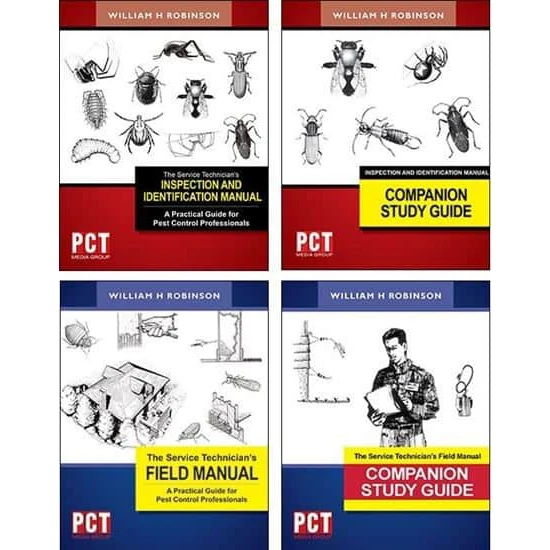
By: William H Robinson
The Service Technician's Inspection and Identification Training Program is the second in the Practical Guide for Pest Control Professionals series by William H Robinson.
The program includes a copy of The Service Technician's Inspection and Identification Manual, the Inspection & Identification Companion Study Guide, and an instructor's DVD. The three resources provide a toolset for managers to conduct 14-session classroom or individual training.
This comprehensive Inspection and Identification Training Program by Dr. William Robinson (comes with a 100% money back guarantee of satisfaction) includes a 124-page, fully illustrated Inspection and Identification Manual detailing essential situation-specific pest management practices, which provides information to help the technician anticipate the common pests or damage that will be found during site inspections, as well as a 62-page Companion Study Guide which contains a brief overview of topic key points, and “10 Things to Know” with space for note-taking and review designed to reinforce the key information in the Inspection and Identification Manual.
Both the Inspection and Identification Manual and Companion Study Guide enable each employee to follow along and take notes in the study guide, and then retain the manual and guide as a permanent reference resource.
Program topics are presented in 14 chapters for managers to conduct 14 individual classroom training sessions to pace and measure individual learning.
Chapters:
1) Introduction
2) Inspection Sites (with 25 specific sites detailed)
3) Ants, Bees, Wasps
4) Bed Bugs, Stink Bugs, Boxelder Bugs
5) Beetles
6) Cockroaches
7) Crickets, Earwigs, Springtails
8) Flea, Lice, Silverfish, Psocids
9) Flies, Mosquitoes
10) Moths
11) Termites
12) Ticks, Mites, Sowbugs
13) Spiders, Centipedes, Millipedes, Scorpions
14) Vertebrates
The program also includes an Instructor’s DVD, which contains PowerPoint presentations for classroom training, a test bank of quizzes, and a spreadsheet on which to keep track of students’ quiz grades for training verification purposes.
The Service Technician’s Training Program
This is an unequalled resource for cost effective in-house training of new service technician hires, as well as a vital resource for providing ongoing review training for seasoned service professionals.
This comprehensive Training Program by Dr. William Robinson (comes with a 100% money back guarantee of satisfaction) includes a 218 page, fully-illustrated, Service Technician’s Field Manual detailing essential situation-specific pest management practices, including helpful insights about dozens of common and not-so-common structural pests, as well as a 91 page Companion Study Guide which contains a brief overview of topic key points, and “10 Things to Know” with space for note-taking and review designed to reinforce the key information in the Field Manual.
Both the Field Manual and Companion Study Guide enable each employee to follow along and take notes in the study guide, and then retain the manual and guide as a permanent reference resource.
Program topics are presented in 20 Chapters for managers to conduct 20 individual classroom training sessions to pace and measure individual learning.
Chapters:
1) The Next Generation Service Technician
2) IPM: Detection and Monitoring
3) Non-Chemical Control Methods
4) Chemical Insecticides
5) Insecticide Formulations
6) Application Technology
7) Transfer of a Toxic Dose
8) Application Economics
9) Structural Wood & Urban Soil
10) Exterior & Interior Features
11) Termite Control
12) Wood-Infesting Insect Control
13) Structural Fumigation
14) Indoor Insecticide Application
15) Outdoor Insecticide Application
16) Rodent Control
17) Insecticide Application Equipment
18) Equipment Repair and Maintenance
19) Pesticide Application Safety
20) Measures and Calculations
The program also includes an Instructor’s DVD, which contains PowerPoint presentations for classroom training, a test bank of quizzes, and a spreadsheet on which to keep track of students’ quiz grades for training verification purposes.